Seat Alhambra 2011 Owner's Manual
Manufacturer: SEAT, Model Year: 2011, Model line: Alhambra, Model: Seat Alhambra 2011Pages: 385, PDF Size: 7.92 MB
Page 181 of 385
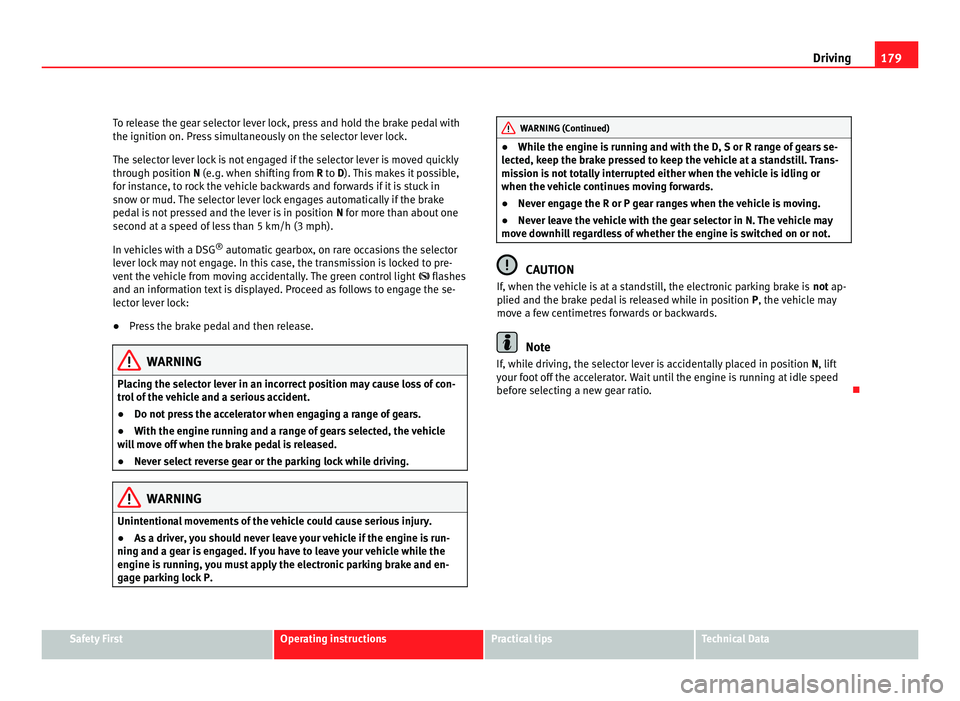
179
Driving
To release the gear selector lever lock, press and hold the brake pedal with
the ignition on. Pre s
s simultaneously on the selector lever lock.
The selector lever lock is not engaged if the selector lever is moved quickly
through position N (e.g. when shifting from R to D). This makes it possible,
for instance, to rock the vehicle backwards and forwards if it is stuck in
snow or mud. The selector lever lock engages automatically if the brake
pedal is not pressed and the lever is in position N for more than about one
second at a speed of less than 5 km/h (3 mph).
In vehicles with a DSG ®
automatic gearbox, on rare occasions the selector
lever lock may not engage. In this case, the transmission is locked to pre-
vent the vehicle from moving accidentally. The green control light flashes
and an information text is displayed. Proceed as follows to engage the se-
lector lever lock:
● Press the brake pedal and then release. WARNING
Placing the selector lever in an incorrect position may cause loss of con-
tro l
of the vehicle and a serious accident.
● Do not press the accelerator when engaging a range of gears.
● With the engine running and a range of gears selected, the vehicle
wil
l move off when the brake pedal is released.
● Never select reverse gear or the parking lock while driving. WARNING
Unintentional movements of the vehicle could cause serious injury.
● As a driver, you should never leave your vehicle if the engine is run-
ning and a g e
ar is engaged. If you have to leave your vehicle while the
engine is running, you must apply the electronic parking brake and en-
gage parking lock P. WARNING (Continued)
● Whi le the engine is running and with the D, S or R range of gears se-
l ect
ed, keep the brake pressed to keep the vehicle at a standstill. Trans-
mission is not totally interrupted either when the vehicle is idling or
when the vehicle continues moving forwards.
● Never engage the R or P gear ranges when the vehicle is moving.
● Never leave the vehicle with the gear selector in N. The vehicle may
move do
wnhill regardless of whether the engine is switched on or not. CAUTION
If, when the vehicle is at a standstill, the electronic parking brake is not ap-
plied and the br ak
e pedal is released while in position P, the vehicle may
move a few centimetres forwards or backwards. Note
If, while driving, the selector lever is accidentally placed in position N, lift
y our f
oot off the accelerator. Wait until the engine is running at idle speed
before selecting a new gear ratio. Safety First Operating instructions Practical tips Technical Data
Page 182 of 385
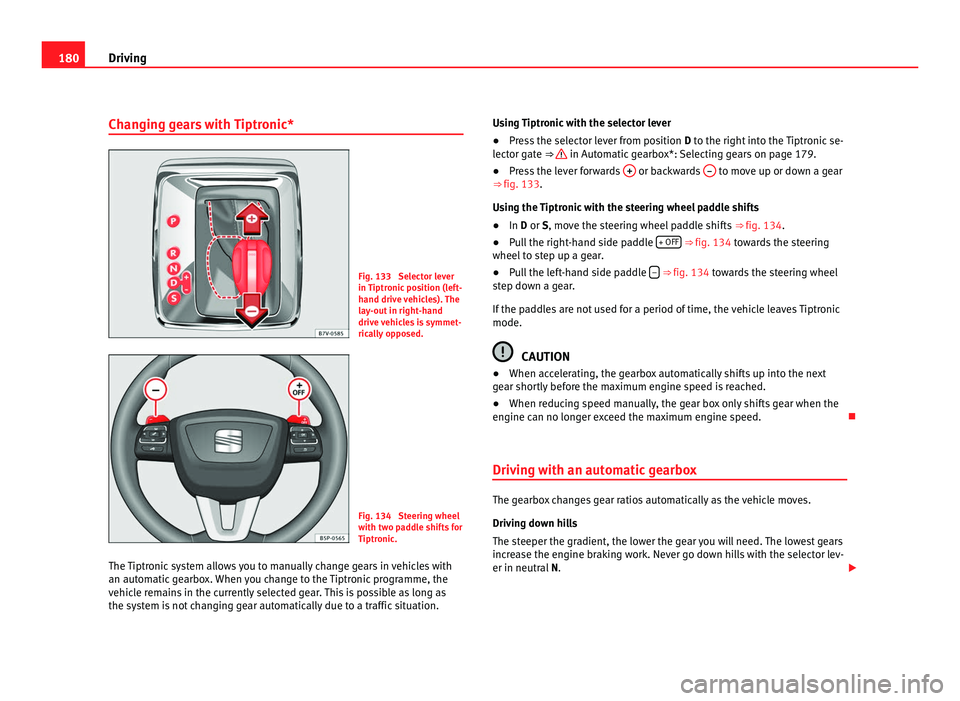
180
Driving
Changing gears with Tiptronic* Fig. 133 Selector lever
in Tiptr
onic
position (left-
hand drive vehicles). The
lay-out in right-hand
drive vehicles is symmet-
rically opposed. Fig. 134 Steering wheel
with tw
o p
addle shifts for
Tiptronic.
The Tiptronic system allows you to manually change gears in vehicles with
an automatic
gearbox. When you change to the Tiptronic programme, the
vehicle remains in the currently selected gear. This is possible as long as
the system is not changing gear automatically due to a traffic situation. Using Tiptronic with the selector lever
●
Press the selector lever from position D to the right int
o the Tiptronic se-
lector gate ⇒ in Automatic gearbox*: Selecting gears on page 179.
● Press the lever forwards + or backwards
– to move up or down a gear
⇒ fig. 133.
Us in
g the Tiptronic with the steering wheel paddle shifts
● In D or S, move the s
teering wheel paddle shifts ⇒ fig. 134.
● Pull the right-hand side paddle + OFF ⇒
fig. 134 t
owards the steering
wheel to step up a gear.
● Pull the left-hand side paddle – ⇒ fig. 134 to
w
ards the steering wheel
step down a gear.
If the paddles are not used for a period of time, the vehicle leaves Tiptronic
mode. CAUTION
● When acc el
erating, the gearbox automatically shifts up into the next
gear shortly before the maximum engine speed is reached.
● When reducing speed manually, the gear box only shifts gear when the
engine can no lon
ger exceed the maximum engine speed.
Driving with an automatic gearbox The gearbox changes gear ratios automatically as the vehicle moves.
Drivin
g do
wn hills
The steeper the gradient, the lower the gear you will need. The lowest gears
increase the engine braking work. Never go down hills with the selector lev-
er in neutral N.
Page 183 of 385
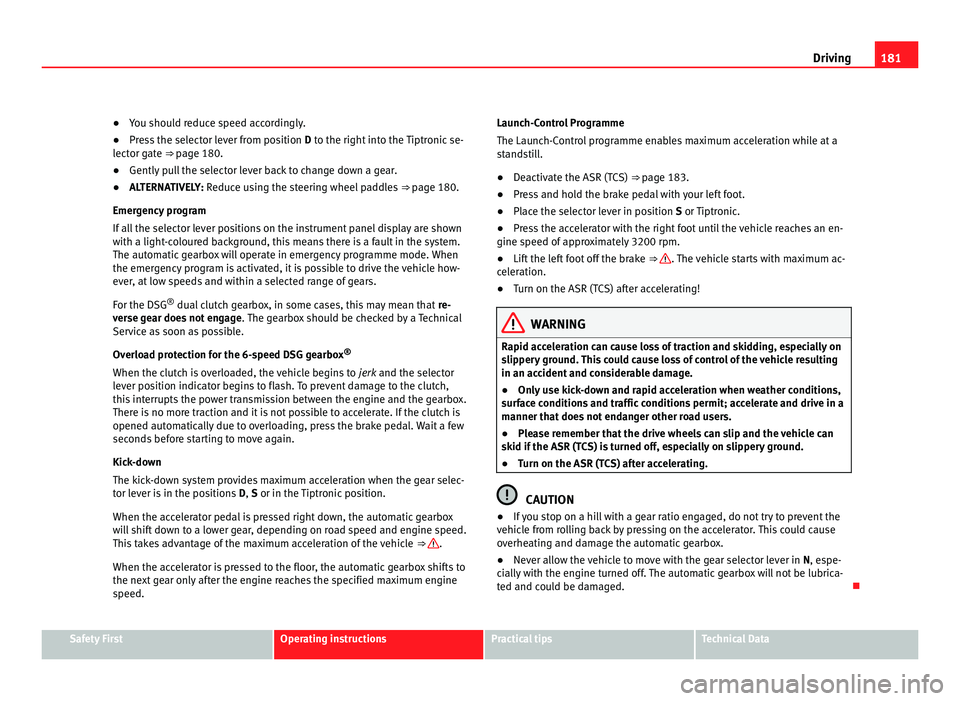
181
Driving
● You should reduce speed accordingly.
● Pre
ss the selector lever from position D to the right int
o the Tiptronic se-
lector gate ⇒ page 180.
● Gently pull the selector lever back to change down a gear.
● ALTERNATIVELY: Reduce u
sing the steering wheel paddles ⇒ page 180.
Emergency program
If all the selector lever positions on the instrument panel display are shown
with a light-coloured background, this means there is a fault in the system.
The automatic gearbox will operate in emergency programme mode. When
the emergency program is activated, it is possible to drive the vehicle how-
ever, at low speeds and within a selected range of gears.
For the DSG ®
dual clutch gearbox, in some cases, this may mean that re-
verse gear does not engage . The gearbox should be checked by a Technical
Service as soon as possible.
Overload protection for the 6-speed DSG gearbox ®
When the clutch is overloaded, the vehicle begins to jerk and the selector
lever position indicator begins to flash. To prevent damage to the clutch,
this interrupts the power transmission between the engine and the gearbox.
There is no more traction and it is not possible to accelerate. If the clutch is
opened automatically due to overloading, press the brake pedal. Wait a few
seconds before starting to move again.
Kick-down
The kick-down system provides maximum acceleration when the gear selec-
tor lever is in the positions D, S or in the Tiptronic position.
When the accelerator pedal is pressed right down, the automatic gearbox
will shift down to a lower gear, depending on road speed and engine speed.
This takes advantage of the maximum acceleration of the vehicle ⇒ .
When the acc el
erator is pressed to the floor, the automatic gearbox shifts to
the next gear only after the engine reaches the specified maximum engine
speed. Launch-Control Programme
The Launch-C
ontrol programme enables maximum acceleration while at a
standstill.
● Deactivate the ASR (TCS) ⇒ page 183.
● Pr
ess and hold the brake pedal with your left foot.
● Place the selector lever in position S or Tiptronic
.
● Press the accelerator with the right foot until the vehicle reaches an en-
gine speed of ap
proximately 3200 rpm.
● Lift the left foot off the brake ⇒ . The vehicle starts with maximum ac-
cel er
ation.
● Turn on the ASR (TCS) after accelerating! WARNING
Rapid acceleration can cause loss of traction and skidding, especially on
slip per
y ground. This could cause loss of control of the vehicle resulting
in an accident and considerable damage.
● Only use kick-down and rapid acceleration when weather conditions,
surf
ace conditions and traffic conditions permit; accelerate and drive in a
manner that does not endanger other road users.
● Please remember that the drive wheels can slip and the vehicle can
skid if the ASR (T
CS) is turned off, especially on slippery ground.
● Turn on the ASR (TCS) after accelerating. CAUTION
● If you stop on a hill with a gear ratio engaged, do not try to prevent the
v ehic
le from rolling back by pressing on the accelerator. This could cause
overheating and damage the automatic gearbox.
● Never allow the vehicle to move with the gear selector lever in N, espe-
c
ially with the engine turned off. The automatic gearbox will not be lubrica-
ted and could be damaged. Safety First Operating instructions Practical tips Technical Data
Page 184 of 385
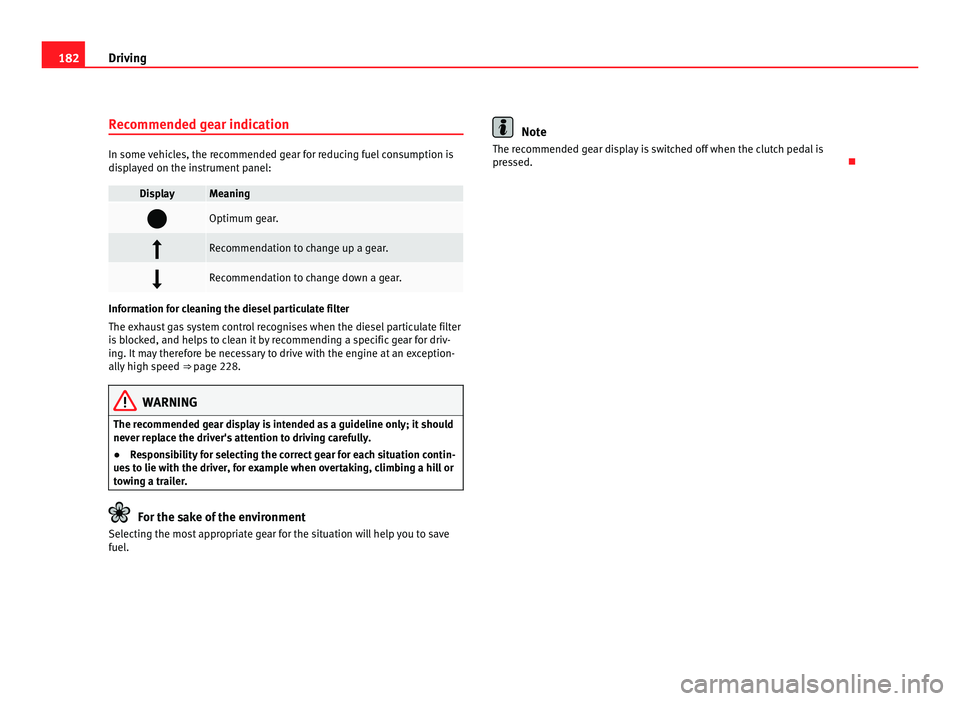
182
Driving
Recommended gear indication In some vehicles, the recommended gear for reducing fuel consumption is
dis
p
layed on the instrument panel: Display Meaning
Optimum gear.
Recommendation to change up a gear.
Recommendation to change down a gear.
Information for cleaning the diesel particulate filter
The exh
au
st gas system control recognises when the diesel particulate filter
is blocked, and helps to clean it by recommending a specific gear for driv-
ing. It may therefore be necessary to drive with the engine at an exception-
ally high speed ⇒ page 228. WARNING
The recommended gear display is intended as a guideline only; it should
never r ep
lace the driver's attention to driving carefully.
● Responsibility for selecting the correct gear for each situation contin-
ues t
o lie with the driver, for example when overtaking, climbing a hill or
towing a trailer. For the sake of the environment
Selecting the most appropriate gear for the situation will help you to save
fuel . Note
The recommended gear display is switched off when the clutch pedal is
pre s
sed.
Page 185 of 385
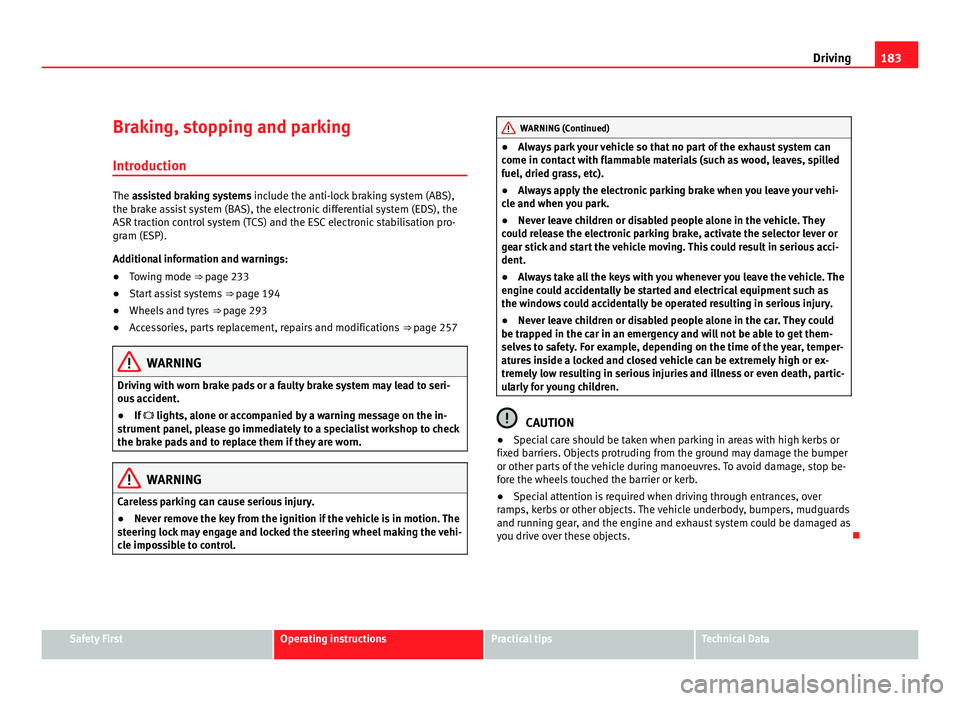
183
Driving
Braking, stopping and parking
Introduction The assisted braking systems include the anti-lock braking system (ABS),
the br
ak
e assist system (BAS), the electronic differential system (EDS), the
ASR traction control system (TCS) and the ESC electronic stabilisation pro-
gram (ESP).
Additional information and warnings:
● Towing mode ⇒ page 233
● St
art assist systems ⇒ page 194
● Wheel
s and tyres ⇒ page 293
● A
ccessories, parts replacement, repairs and modifications ⇒ page 257WARNING
Driving with worn brake pads or a faulty brake system may lead to seri-
ous ac
cident.
● If lights, alone or accompanied by a warning message on the in-
strument
panel, please go immediately to a specialist workshop to check
the brake pads and to replace them if they are worn. WARNING
Careless parking can cause serious injury.
● Never remove the key from the ignition if the vehicle is in motion. The
st eerin
g lock may engage and locked the steering wheel making the vehi-
cle impossible to control. WARNING (Continued)
● Always park your vehicle so that no part of the exhaust system can
c ome in c
ontact with flammable materials (such as wood, leaves, spilled
fuel, dried grass, etc).
● Always apply the electronic parking brake when you leave your vehi-
cle and when
you park.
● Never leave children or disabled people alone in the vehicle. They
coul
d release the electronic parking brake, activate the selector lever or
gear stick and start the vehicle moving. This could result in serious acci-
dent.
● Always take all the keys with you whenever you leave the vehicle. The
engine cou
ld accidentally be started and electrical equipment such as
the windows could accidentally be operated resulting in serious injury.
● Never leave children or disabled people alone in the car. They could
be trapped in the c
ar in an emergency and will not be able to get them-
selves to safety. For example, depending on the time of the year, temper-
atures inside a locked and closed vehicle can be extremely high or ex-
tremely low resulting in serious injuries and illness or even death, partic-
ularly for young children. CAUTION
● Special care should be taken when parking in areas with high kerbs or
fi x
ed barriers. Objects protruding from the ground may damage the bumper
or other parts of the vehicle during manoeuvres. To avoid damage, stop be-
fore the wheels touched the barrier or kerb.
● Special attention is required when driving through entrances, over
ramps, k
erbs or other objects. The vehicle underbody, bumpers, mudguards
and running gear, and the engine and exhaust system could be damaged as
you drive over these objects. Safety First Operating instructions Practical tips Technical Data
Page 186 of 385
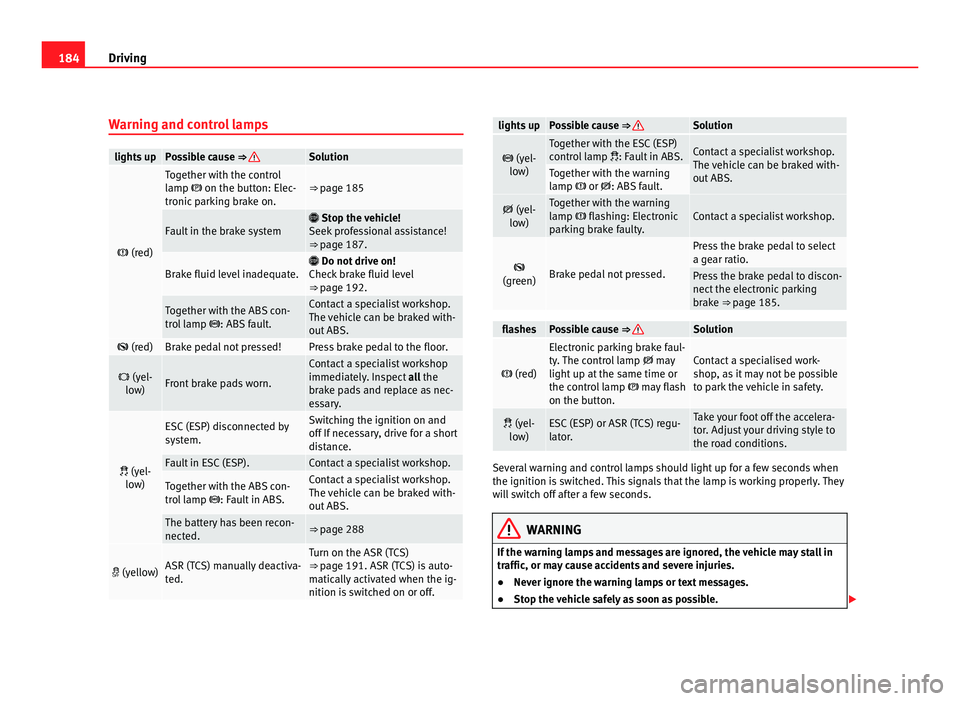
184
Driving
Warning and control lamps lights up Possible cause ⇒ Solution
(red) Together with the control
lamp
on the b
utton: Elec-
tronic parking brake on. ⇒ page 185
Fault in the brake system
Stop the vehicle!
Seek pr
ofessional assistance!
⇒ page 187. Brake fluid level inadequate.
Do not drive on!
Chec k
brake fluid level
⇒ page 192. Together with the ABS con-
tro
l
lamp : ABS fault. Contact a specialist workshop.
The v
ehic
le can be braked with-
out ABS. (red) Brake pedal not pressed! Press brake pedal to the floor.
(yel-
lo w) Front brake pads worn. Contact a specialist workshop
immediat
ely
. Inspect all the
brake pads and replace as nec-
essary.
(yel-
lo w) ESC (ESP) disconnected by
sys
t
em. Switching the ignition on and
off If
nec
essary, drive for a short
distance. Fault in ESC (ESP). Contact a specialist workshop.
Together with the ABS con-
tro
l
lamp : Fault in ABS. Contact a specialist workshop.
The v
ehic
le can be braked with-
out ABS. The battery has been recon-
nected.
⇒ page 288
(yellow) ASR (TCS) manually deactiva-
ted. Turn on the ASR (TCS)
⇒ pag
e 191. ASR (T
CS) is auto-
matically activated when the ig-
nition is switched on or off. lights up Possible cause ⇒ Solution
(yel-
lo w) Together with the ESC (ESP)
contr
o
l lamp : Fault in ABS. Contact a specialist workshop.
The v
ehic
le can be braked with-
out ABS. Together with the warning
lamp
or : ABS fault. (yel-
lo w) Together with the warning
lamp
flashing: Electronic
parking brake faulty. Contact a specialist workshop.
(green) Brake pedal not pressed. Press the brake pedal to select
a ge
ar r
atio. Press the brake pedal to discon-
nect the el
ectr
onic parking
brake ⇒ page 185. flashes Possible cause ⇒ Solution
(red) Electronic parking brake faul-
ty.
The c
ontrol lamp may
light up at the same time or
the control lamp may flash
on the button. Contact a specialised work-
shop, a
s
it may not be possible
to park the vehicle in safety. (yel-
lo w) ESC (ESP) or ASR (TCS) regu-
lat
or
. Take your foot off the accelera-
tor
. Adju
st your driving style to
the road conditions. Several warning and control lamps should light up for a few seconds when
the ignition is
sw
itched. This signals that the lamp is working properly. They
will switch off after a few seconds. WARNING
If the warning lamps and messages are ignored, the vehicle may stall in
traffic, or m a
y cause accidents and severe injuries.
● Never ignore the warning lamps or text messages.
● Stop the vehicle safely as soon as possible.
Page 187 of 385
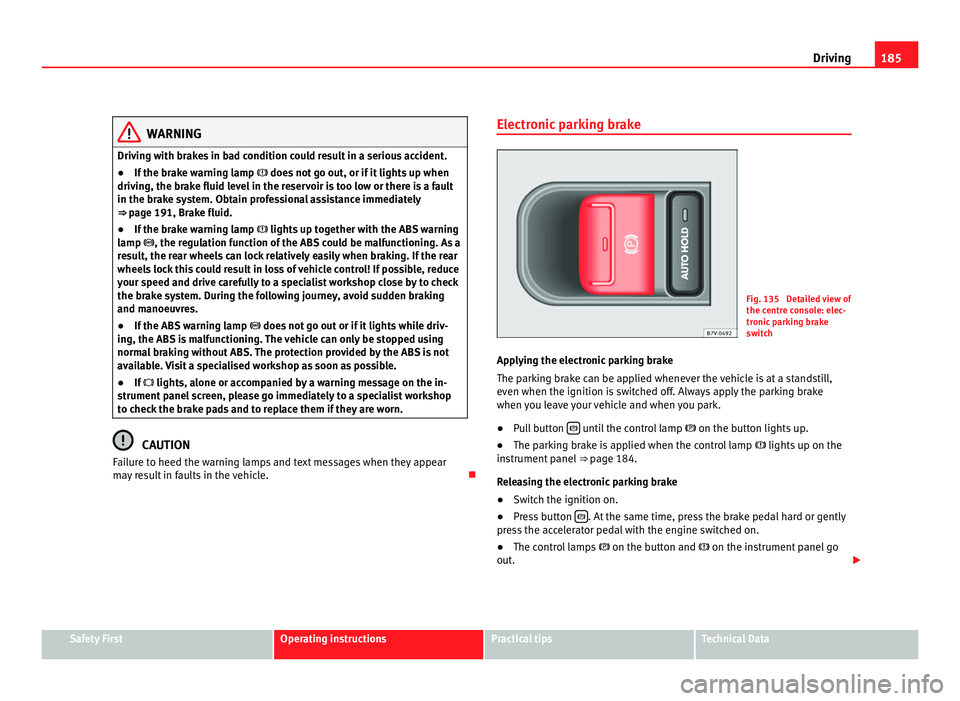
185
Driving WARNING
Driving with brakes in bad condition could result in a serious accident.
● If the brake warning lamp does not go out, or if it lights up when
driving, the brake fluid level in the reservoir is too low or there is a fault
in the brake system. Obtain professional assistance immediately
⇒ page 191, Brake fluid.
● If the brake warning lamp lights up t
ogether with the ABS warning
lamp , the regulation function of the ABS could be malfunctioning. As a
result, the rear wheels can lock relatively easily when braking. If the rear
wheels lock this could result in loss of vehicle control! If possible, reduce
your speed and drive carefully to a specialist workshop close by to check
the brake system. During the following journey, avoid sudden braking
and manoeuvres.
● If the ABS warning lamp does not
go out or if it lights while driv-
ing, the ABS is malfunctioning. The vehicle can only be stopped using
normal braking without ABS. The protection provided by the ABS is not
available. Visit a specialised workshop as soon as possible.
● If lights, alone or accompanied by a warning message on the in-
strument
panel screen, please go immediately to a specialist workshop
to check the brake pads and to replace them if they are worn. CAUTION
Failure to heed the warning lamps and text messages when they appear
ma y
result in faults in the vehicle. Electronic parking brake Fig. 135 Detailed view of
the centr
e c
onsole: elec-
tronic parking brake
switch
Applying the electronic parking brake
The parkin
g brake can be applied whenever the vehicle is at a standstill,
even when the ignition is switched off. Always apply the parking brake
when you leave your vehicle and when you park.
● Pull button until the control lamp
on the button lights
up.
● The parking brake is applied when the control lamp lights up on the
ins
trument panel ⇒ page 184.
Releasing the electronic parking brake
● Switch the ignition on.
● Press button . At the same time, press the brake pedal hard or gently
pre s
s the accelerator pedal with the engine switched on.
● The control lamps on the button and
on the instrument panel go
out. Safety First Operating instructions Practical tips Technical Data
Page 188 of 385
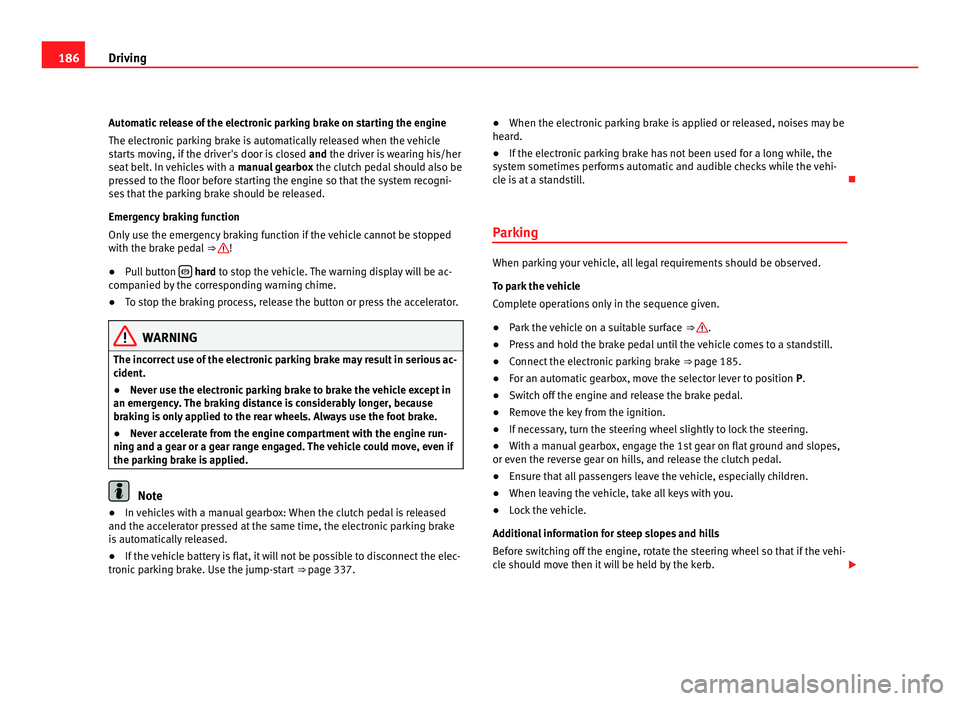
186
Driving
Automatic release of the electronic parking brake on starting the engine
The electr onic
parking brake is automatically released when the vehicle
starts moving, if the driver's door is closed and the driver is wearing his/her
seat belt. In vehicles with a manual gearbox the clutch pedal should also be
pressed to the floor before starting the engine so that the system recogni-
ses that the parking brake should be released.
Emergency braking function
Only use the emergency braking function if the vehicle cannot be stopped
with the brake pedal ⇒ !
● Pull button hard to stop the vehicle. The warning display will be ac-
c omp
anied by the corresponding warning chime.
● To stop the braking process, release the button or press the accelerator. WARNING
The incorrect use of the electronic parking brake may result in serious ac-
cident .
● Nev
er use the electronic parking brake to brake the vehicle except in
an emergency
. The braking distance is considerably longer, because
braking is only applied to the rear wheels. Always use the foot brake.
● Never accelerate from the engine compartment with the engine run-
ning and a ge
ar or a gear range engaged. The vehicle could move, even if
the parking brake is applied. Note
● In vehicles with a manual gearbox: When the clutch pedal is released
and the ac c
elerator pressed at the same time, the electronic parking brake
is automatically released.
● If the vehicle battery is flat, it will not be possible to disconnect the elec-
tronic p
arking brake. Use the jump-start ⇒ page 337. ●
When the electronic
parking brake is applied or released, noises may be
heard.
● If the electronic parking brake has not been used for a long while, the
syst
em sometimes performs automatic and audible checks while the vehi-
cle is at a standstill.
Parking When parking your vehicle, all legal requirements should be observed.
To p
ark
the vehicle
Complete operations only in the sequence given.
● Park the vehicle on a suitable surface ⇒ .
● Press and hold the brake pedal until the vehicle comes to a standstill.
● Connect the electronic parking brake ⇒ page 185.
● F
or an automatic gearbox, move the selector lever to position P.
● Switch off the engine and release the brake pedal.
● Remove the key from the ignition.
● If necessary, turn the steering wheel slightly to lock the steering.
● With a manual gearbox, engage the 1st gear on flat ground and slopes,
or even the rev
erse gear on hills, and release the clutch pedal.
● Ensure that all passengers leave the vehicle, especially children.
● When leaving the vehicle, take all keys with you.
● Lock the vehicle.
Additiona
l information for steep slopes and hills
Before switching off the engine, rotate the steering wheel so that if the vehi-
cle should move then it will be held by the kerb.
Page 189 of 385
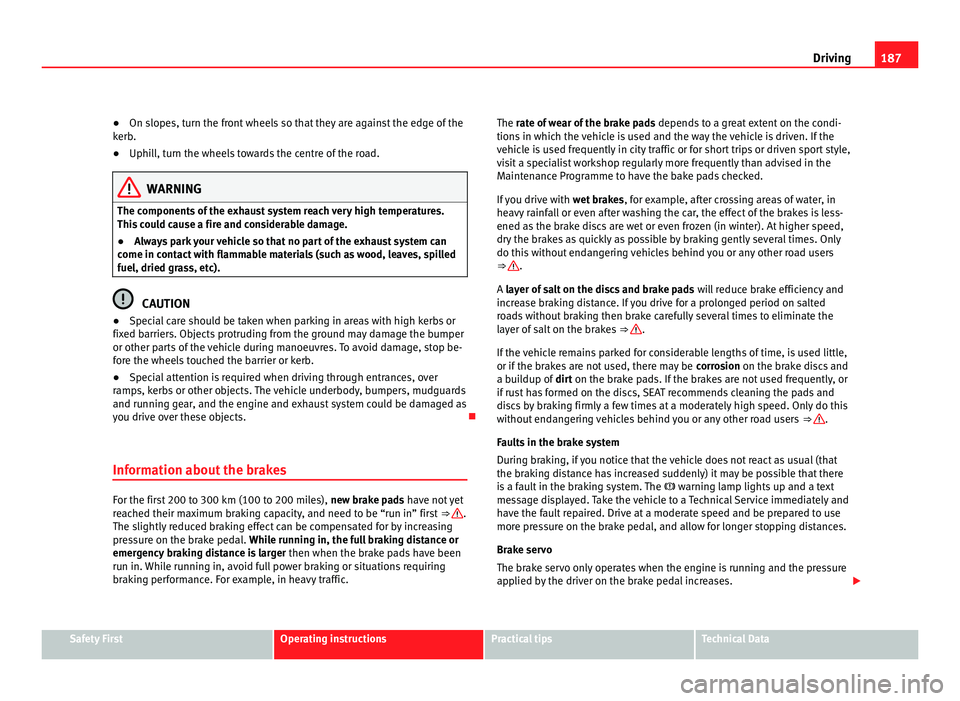
187
Driving
● On slopes, turn the front wheels so that they are against the edge of the
k erb
.
● Uphill, turn the wheels towards the centre of the road. WARNING
The components of the exhaust system reach very high temperatures.
This c
ould cause a fire and considerable damage.
● Always park your vehicle so that no part of the exhaust system can
come in cont
act with flammable materials (such as wood, leaves, spilled
fuel, dried grass, etc). CAUTION
● Special care should be taken when parking in areas with high kerbs or
fi x
ed barriers. Objects protruding from the ground may damage the bumper
or other parts of the vehicle during manoeuvres. To avoid damage, stop be-
fore the wheels touched the barrier or kerb.
● Special attention is required when driving through entrances, over
ramps, k
erbs or other objects. The vehicle underbody, bumpers, mudguards
and running gear, and the engine and exhaust system could be damaged as
you drive over these objects.
Information about the brakes For the first 200 to 300 km (100 to 200 miles),
new brake p
ads have not yet
reached their maximum braking capacity, and need to be “run in” first ⇒ .
The slightly r
educed braking effect can be compensated for by increasing
pressure on the brake pedal. While running in, the full braking distance or
emergency braking distance is larger then when the brake pads have been
run in. While running in, avoid full power braking or situations requiring
braking performance. For example, in heavy traffic. The rate of wear of the brake pads
depends
to a great extent on the condi-
tions in which the vehicle is used and the way the vehicle is driven. If the
vehicle is used frequently in city traffic or for short trips or driven sport style,
visit a specialist workshop regularly more frequently than advised in the
Maintenance Programme to have the bake pads checked.
If you drive with wet brakes, for example, after crossing areas of water, in
heavy rainfall or even after washing the car, the effect of the brakes is less-
ened as the brake discs are wet or even frozen (in winter). At higher speed,
dry the brakes as quickly as possible by braking gently several times. Only
do this without endangering vehicles behind you or any other road users
⇒ .
A la y
er of salt on the discs and brake pads will reduce brake efficiency and
increase braking distance. If you drive for a prolonged period on salted
roads without braking then brake carefully several times to eliminate the
layer of salt on the brakes ⇒ .
If the v
ehicle remains parked for considerable lengths of time, is used little,
or if the brakes are not used, there may be corrosion on the brake discs and
a buildup of dirt on the brake pads. If the brakes are not used frequently, or
if rust has formed on the discs, SEAT recommends cleaning the pads and
discs by braking firmly a few times at a moderately high speed. Only do this
without endangering vehicles behind you or any other road users ⇒ .
Fau lt
s in the brake system
During braking, if you notice that the vehicle does not react as usual (that
the braking distance has increased suddenly) it may be possible that there
is a fault in the braking system. The warning lamp lights up and a text
message displayed. Take the vehicle to a Technical Service immediately and
have the fault repaired. Drive at a moderate speed and be prepared to use
more pressure on the brake pedal, and allow for longer stopping distances.
Brake servo
The brake servo only operates when the engine is running and the pressure
applied by the driver on the brake pedal increases. Safety First Operating instructions Practical tips Technical Data
Page 190 of 385
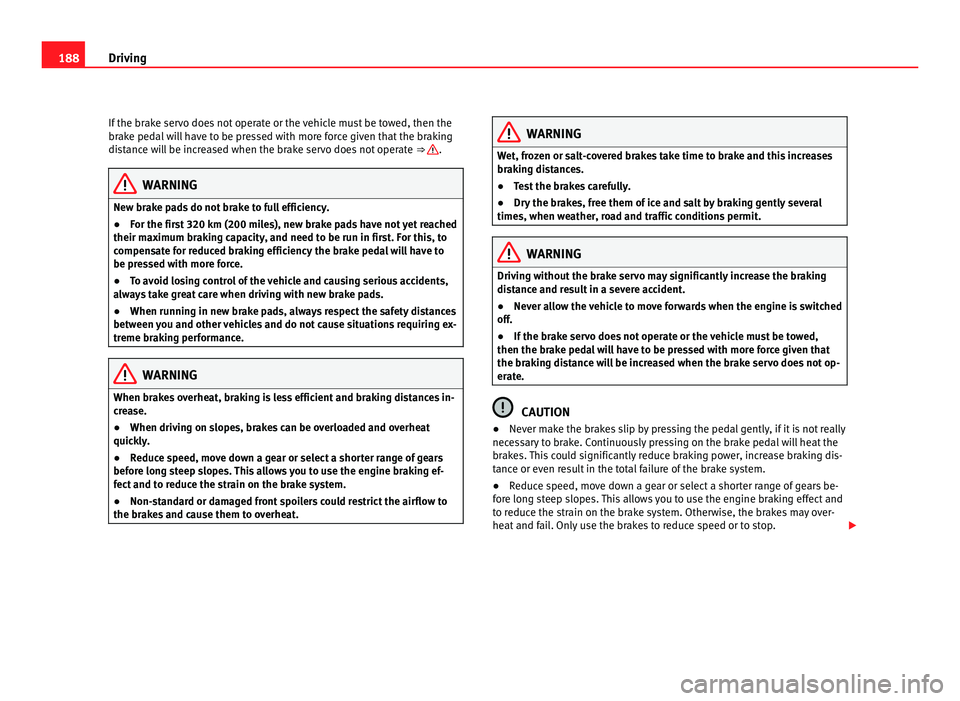
188
Driving
If the brake servo does not operate or the vehicle must be towed, then the
brak e ped
al will have to be pressed with more force given that the braking
distance will be increased when the brake servo does not operate ⇒ .
WARNING
New brake pads do not brake to full efficiency.
● For the first 320 km (200 miles), new brake pads have not yet reached
their max imum br
aking capacity, and need to be run in first. For this, to
compensate for reduced braking efficiency the brake pedal will have to
be pressed with more force.
● To avoid losing control of the vehicle and causing serious accidents,
alwa
ys take great care when driving with new brake pads.
● When running in new brake pads, always respect the safety distances
between y
ou and other vehicles and do not cause situations requiring ex-
treme braking performance. WARNING
When brakes overheat, braking is less efficient and braking distances in-
cr e
ase.
● When driving on slopes, brakes can be overloaded and overheat
quickly
.
● Reduce speed, move down a gear or select a shorter range of gears
before lon
g steep slopes. This allows you to use the engine braking ef-
fect and to reduce the strain on the brake system.
● Non-standard or damaged front spoilers could restrict the airflow to
the brake
s and cause them to overheat. WARNING
Wet, frozen or salt-covered brakes take time to brake and this increases
brak in
g distances.
● Test the brakes carefully.
● Dry the brakes, free them of ice and salt by braking gently several
times, when we
ather, road and traffic conditions permit. WARNING
Driving without the brake servo may significantly increase the braking
dist
ance and result in a severe accident.
● Never allow the vehicle to move forwards when the engine is switched
off.
● If the br
ake servo does not operate or the vehicle must be towed,
then the brake ped
al will have to be pressed with more force given that
the braking distance will be increased when the brake servo does not op-
erate. CAUTION
● Never make the brakes slip by pressing the pedal gently, if it is not really
nec e
ssary to brake. Continuously pressing on the brake pedal will heat the
brakes. This could significantly reduce braking power, increase braking dis-
tance or even result in the total failure of the brake system.
● Reduce speed, move down a gear or select a shorter range of gears be-
fore lon
g steep slopes. This allows you to use the engine braking effect and
to reduce the strain on the brake system. Otherwise, the brakes may over-
heat and fail. Only use the brakes to reduce speed or to stop.